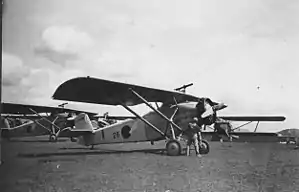Mitsubishi 2MR8
The Mitsubishi Army Type 92 Reconnaissance Aircraft (九二式偵察機) (company designation 2MR8) was a Japanese short-range reconnaissance aircraft of the 1930s designed by Mitsubishi for the Imperial Japanese Army Air Force. A total of 230 were built, serving between 1933 and 1936. A parasol monoplane, the Type 92 was the first military aircraft powered by an engine both designed and manufactured in Japan to enter service.
| Type 92 Reconnaissance Aircraft | |
|---|---|
 | |
| Role | Reconnaissance aircraft |
| Manufacturer | Mitsubishi |
| First flight | 28 March 1931 |
| Introduction | 1932 |
| Primary user | Imperial Japanese Army Air Force |
| Number built | 234 (4 prototypes + 230 production aircraft) |
Development and design
In 1930, Mitsubishi developed two designs to meet a Japanese Army requirement for a short-range reconnaissance aircraft to supplement the larger, long-range Kawasaki Type 88, the 2MR7, a biplane based on its earlier 2MR reconnaissance aircraft and B2M torpedo bomber developed for the Imperial Japanese Navy, and the 2MR8, a high-wing parasol monoplane.[1]
The first of four prototypes flew on 28 March 1931, powered by a 239 kW (320 hp) Mitsubishi A2 radial engine. Successive prototypes were modified with more powerful engines, reduced wing area and a shorter fuselage until the fourth prototype was accepted by the Japanese Army, and ordered into service as the Type 92 Reconnaissance Aircraft.[2]
The production Type 92 had fixed wide-track divided landing gear, and was powered by a 354 kW (450 hp) Mitsubishi Type 92 radial engine. It carried a crew of two in open cockpits, with an armament of two synchronised, forward-firing 7.7 mm (.303 in) machine guns and one or two flexibly-mounted guns on the observer's cockpit. Production completed in 1934 after a total of 230 aircraft were built.[2]
To meet the requirements of the Japanese Ministry of Railways for a survey aircraft, Mitsubishi developed a civilian version of the Type 92, the Hato survey aircraft. A single aircraft was ordered in 1935, together with a Fokker Super Universal built by Nakajima. Powered by a 298 kW (400 hp) Mitsubishi A5 engine, it differed from the military version in having a glazed canopy over the rear cockpit (which accommodated a crew of two), an open forward pilot's cockpit, and spat-type main wheel fairings. It was delivered in March 1936 and registered J-AARA.[3]
Operational history
The Type 92 saw active service in Manchuria with the air battalions (later expanded to air wings) of the Kwantung Army Air Corps between 1933 and 1936.[4] The Mitsubishi Type 92 was also used by the Chinese Air Force in the early stages of the Second Sino-Japanese War.[5]
Operators
- Kwangsi Air Force purchased two Type 92s in September 1934, with a few more being purchased in 1935.[5]
Specifications
Data from Japanese Aircraft, 1910-1941[2]
General characteristics
- Crew: 2
- Length: 8.52 m (27 ft 11 in)
- Wingspan: 12.75 m (41 ft 10 in)
- Height: 3.48 m (11 ft 5 in)
- Wing area: 26 m2 (280 sq ft)
- Empty weight: 1,060 kg (2,337 lb)
- Gross weight: 1,770 kg (3,902 lb)
- Powerplant: 1 × Mitsubishi Army Type 92 400hp Air Cooled Radial 9-cylinder air-cooled radial piston engine, 298–354 kW (400–475 hp) (company designation A5)
- Propellers: 2-bladed Reed-type fixed-pitch metal propeller
Performance
- Maximum speed: 220 km/h (140 mph, 120 kn)
- Endurance: 4-5 hours
- Service ceiling: 5,700 m (18,700 ft)
- Time to altitude: 3,000 m (9,843 ft) in10 minutes 30 seconds
- Wing loading: 68.1 kg/m2 (13.9 lb/sq ft)
- Power/mass: 0.2381 kW/kg (0.1448 hp/lb)
Armament
- Guns: 2 × fixed forward firing 7.7 mm (0.303 in) machine guns, 2 × flexibly mounted 7.7 mm (0.303 in) machine guns in rear cockpit
References
- Notes
- Mikesh and Abe 1990, p. 180.
- Mikesh and Abe 1990, p. 182.
- Mikesh and Abe 1990, p. 195.
- Donald 1997, p. 647.
- Andersson 2008, pp. 57–60.
- Bibliography
- Andersson, Lennart. A History of Chinese Aviation: Encyclopedia of Aircraft and Aviation in China until 1949. Taipei, Taiwan: AHS of ROC, 2008. ISBN 978-957-28533-3-7.
- Donald, David (editor). The Encyclopedia of World Aircraft. Leicester, UK: Blitz, 1997. ISBN 1-85605-375-X.
- Mikesh, Robert C. and Shorzoe Abe. Japanese Aircraft, 1910-1941. London: Putnam & Company Ltd., 1990. ISBN 0-85177-840-2.